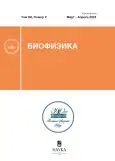Relationship of Geophysical Rhythms with Human Blood Pressure and Heart Rate. Case Study
- Authors: Kovalev P.D1, Kovalev D.P1
-
Affiliations:
- Institute of Marine Geology and Geophysics, Far Eastern Branch of the Russian Academy of Sciences
- Issue: Vol 69, No 2 (2024)
- Pages: 377-385
- Section: Articles
- URL: https://journals.rcsi.science/0006-3029/article/view/257589
- DOI: https://doi.org/10.31857/S0006302924020215
- EDN: https://elibrary.ru/OTFSCV
- ID: 257589
Cite item
Full Text
Abstract
About the authors
P. D Kovalev
Institute of Marine Geology and Geophysics, Far Eastern Branch of the Russian Academy of Sciences
Email: p.kovalev@imgg.ru
Yuzhno-Sakhalinsk, Russia
D. P Kovalev
Institute of Marine Geology and Geophysics, Far Eastern Branch of the Russian Academy of SciencesYuzhno-Sakhalinsk, Russia
References
- Наумова В. В., Земцова Е. С., Щелев Д. Г. и Пилявский С. О. Вариабельность параметров кровообращения в зрелом возрасте. Вестн. Санкт-Петербургского университета. Сер. 11, № 3, 154–163 (2008).
- Pagani M., Lombardi F., Guzzetti S., Rimoldi O., Furlan R., Pizzinelli P., Sandrone G., Malfatto G., Dell'Orto S., and Piccaluga E. Power spectral analysis of heart rate and arterial pressure variabilities as a marker of sympatho-vagal interaction in man and conscious dog. Circ Res., 59 (2), 178–193 (1986). doi: 10.1161/01.res.59.2.178
- Артемова Н. М., Везенова И. В. и Соколов А. В. Суточное мониторирование артериального давления в клинической практике: учебно-методическое пособие для ординаторов по специальности «Функциональная диагностика» (Рязанский гос. мед. университет, Рязань, 2012).
- Бородин А. С. Вариации системного артериального давления человека: учебно-методическое пособие (Томский государственный университет, Томск, 2011).
- Остроумова О. Д., Гусева Т. Ф., Абакумов Ю. Г. и Батутина А. М. Вариабельность систолического и диастолического артериального давления при артериальной гипертензии: клиническая значимость, возможные патогенетические механизмы. Кардиоваск. терапия и профилактика, № 2, 91–94 (2003).
- Баевский Р. М. и Иванов Г. Г. Вариабельность сердечного ритма: теоретические аспекты и возможности клинического применения. Ультразвуковая и функциональная диагностика, № 3, 108–127 (2001).
- Сергейчик О. И. Модели и алгоритмы спектрального анализа обработки кардиологических временных рядов. Автореф. дис. … канд. техн. наук (Тюмень, 2007).
- Хаютин В. М. и Лукошкова Е. В. Колебания частоты сердцебиений: спектральный анализ. Вестн. аритмологии, № 26, 10–21 (2002).
- Steinmeier R., Bauhuf C., Hübner U., Bauer R. D., Fahlbusch R., Laumer R., and Bondar I. Slow rhythmic oscillations of blood pressure, intracranial pressure, microcirculation, and cerebral oxygenation. Dynamic interrelation and time course in humans. Stroke, 27 (12), 2236–2243 (1996). doi: 10.1161/01.str.27.12.2236
- Григорьев А. И. Экология человека: учебник для вузов (ГЭОТАР-Медиа, М., 2013).
- Хильдебрандт Г., Мозер М. и Лехофер М. Хронобиология и хрономедицина. Биологические ритмы и медицинское применение (Арнебия, М., 2006).
- Агулова Л. П. Хронобиология: учеб. пособие (Томск: Томский государственный университет, 2013).
- Крылов В. В. Биологические эффекты геомагнитной активности: наблюдения, эксперименты и возможные механизмы. Труды ИБВВ РАН, № 84 (87), 7–38 (2018).
- Jenkins G. M. and Watts D. G. Spectral analysis and its applications (Holden-Day, San Francisco, 1969).
- Marple S. L. Digital Spectral Analysis, with Applications (Prentice Hall, Englewood Cliffs, New Jersey, 1987).
- Ковалев Д. П. Программа для ЭВМ Kyma. Федеральная служба по интеллектуальной собственности, Свидетельство 2018618778 от 19.07.2018.
- Чибисов С. М., Благонравов М. Л. и Фролов В. А. Телеметрическое мониторирование в патофизиологии сердца и хронокардиологии. Учеб. пособие (РУДН, М., 2008).
- Зубащенко Е. М., Шмыков В. И., Немыкин А. Я. и Полякова Н. В. Региональная физическая география. Климаты Земли: учебно-методическое пособие. Часть 1. (ВГПУ, Воронеж, 2007).
- Солнечная и земная физика. Справочник. 2002–2012 (Сервер «СиЗиФ), http:/www.kosmofizika.ru/spravka.htm.
- Рябова С. А. Геомагнитные вариации и синхронные с ними вариации уровня подземных вод и микросейсмического фона в условиях средних широт. Дис. канд. физ.-мат. наук (М., 2018).
- Солдатенко С. А. Синоптические вихри в атмосфере и океане. Соровский образоват. журн., № 2, 78–84. (1999).
- Larsén X. G., Vincent C. L., and Larsen S. E. Spectral structure of mesoscale winds over the water. Quart. J. Roy. Meteorolog. Soc., 139 (672), 685–700 (2013).
- Lindborg E. Can the atmospheric kinetic energy spectrum be explained by two-dimensional turbulence? J. Fluid Mech., 388, 259–288 (1999).
- Dewan E. M. Stratospheric spectra resembling turbulence. Science, 204, 832–835 (1979).
- Van Zandt T. E. A universal spectrum of buoyancy waves in the atmosphere. Geophys. Res. Lett., 9, 575–578 (1982).
- Gage K. S. Evidence for a k−5/3 law inertial range in mesoscale two-dimensional turbulence. J. Atmos. Sci., 36, 1950–1954 (1979).
- Kraichnan R. H. Inertial ranges in two-dimensional turbulence. Phys. Fluids, 10, 1417–1423 (1967).
- Kraichnan R. H. Inertial-range transfer in two- and three-dimensional turbulence. J. Fluid Mech., 47, 525–535 (1970).
Supplementary files










